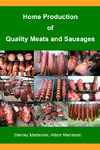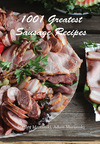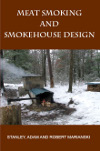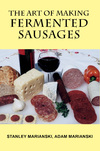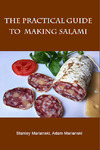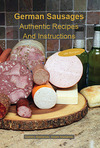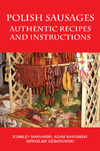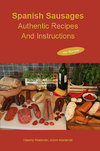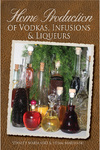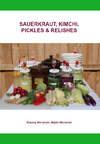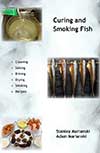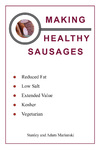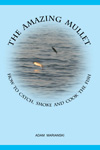Meats and Sausages
Additives
Additives and water retention agents are important in commercially produced meat products. If you examine the list of machinery produced by an average factory, you will see that half of the products are related to pumping water and distributing it within the meat. To perform those operations fast and to produce a product that will be visually appealing with a long shelf life, a number of additives, some natural and some of chemical nature, are added.
Phosphates
Phosphates are the most effective water-holding agents. Salt and most water-binding agents force meat protein to swell, which helps them trap and hold more water. Phosphates go further; they can open the structure of the protein, which helps them to hold even more water. This increased water-holding capacity of the proteins prevents water losses when smoking and cooking. At first, Europe, such as Germany and Poland did not allow the use of phosphates, but after joining the European Common Market, they had to conform to the same regulations and were forced to accept their use. The case of liquid smoke in Germany is very similar. The country did not allow its use, but now, the addition of liquid smoke is permitted. Needless to say, the products were better and healthier before. Phosphates are the strongest water binders and protein extractors, and all commercial producers use them. Most countries permit 0.5% of phosphates (5 g per kilogram of meat). Today, the whole meat industry operates on this principle, injecting the maximum allowed amount of water and ensuring it does not leak out.
There are tetrasodium pyrophosphate, tripolyphosphate, hexametaphosphate, diphosphate, all exhibiting different properties. A meat processor usually obtains a prefabricated phosphate blend that has been optimized for a particular application. American emulsified sausages can hold up to 40% of fats and water over the initial weight of the meat mass. If your starting sausage mass weighed 100 lbs, you have lost 15% during smoking and cooking and you should end up with 85 lbs of product, right? Not a commercial plant, they will add up 10% fat trimmings and 30% water, and the final product weighs 125 lbs. Pure profit thanks to phosphates. In some countries, there are no rules at all, a manufacturer can boost up the original weight of meat mass (100 lbs) to 160 lbs by using water.
Curing Accelerators
Ascorbate is added at 0.4 - 0.6 g per kilogram of t total mass, ascorbate or erythorbate are added at 0.5 - 0.7 g per kilogram of total mass. Curing accelerators are of little use in air-dried products as they deplete the amount of nitrite by increasing nitrite reaction. As a result, less nitrite is available for long time curing.
Ascorbic acid {vitamin C) is an antioxidant used to prolong the product's shelf life by delaying fat rancidity and color changes cased by exposure to oxygen in the air. Ascorbic acid should not be added with sodium nitrite at the same time, as they react violently creating fumes.
Preservatives
Sodium metabisulphite and sodium sulphite are added to keep food safe for longer by preventing the growth of spoilage and pathogenic bacteria.
Sodium lactate or potassium lactate is used to increase the product's shelf-life. Adding up to 3% (30 g/kg) is permitted.
Acetate can be added to increase shelf-life at around 3%. Larger amounts may impart a vinegar-like taste to the product.
Typical Usage Amounts
| Name | Common Amount | Max Allowed |
|---|---|---|
| Sodium ascorbate or erythorbate | 0.4-0.7 g/kg | 7.8 oz. per 100 lbs. of meat, 547 ppm |
| Ascorbic or erythorbic acid | 3/4 oz. per 100 lbs. of meat, 469 ppm | |
| Citric acid or Sodium Citrate | may replace up to half of any one of the above | |
| Phosphate | 0.3% (3 g/kg) | 0.5% (5 g/kg), 5,000 ppm (parts per million) |
| Glucono delta lactone (GDL), see fermented sausages | <1% (10 g/kg) | 8 oz. per 100 lbs of meat |
| Lactate | 3% (30 g/kg) | |
| Acetate | 3% (30 g/kg) |
Natural Ingredients Used for Making Sausages
Water Binders
Soy protein powders are added at around 2% as the larger amounts will affect the taste and flavor of the product. They bind water extremely well and cover fat particles with fine emulsion. This prevents fats from lumping together. Their ability to produce gel contributes to the increased firmness of the product. The sausage will be juicier, plumper and with less shriveling but the amount of added soy protein concentrate should not exceed 3%; otherwise, it may impart a “beany” flavor to the product.
Soy protein isolate is a natural product that contains at least 90% protein and no other ingredients. Soy protein isolate is the stronger and costlier of the two and can bind 5 parts of water.
Soy protein concentrate, available from most online distributors of sausage-making supplies, is a natural product that contains 70% protein plus other ingredients, like ash and oyher fibers. It binds 4 parts of water, improving the sausage's texture.
Non-fat dry milk powder can bind water and is often used in making sausages, including fermented types. Dry milk powder contains 50% lactose (sugar) and is used in fermented sausages as a source of food for lactic acid producing bacteria. It also contains around 35% of protein, about 0.6 - 1% fat and may be considered a healthy high-energy product. Dry milk powder greatly improves the taste of low-fat sausages. Non-fat dry milk powder is a good natural product and does not affect the flavor of the product. It is added at about 3% and effectively binds water and emulsifies fats. Its action is very similar to that of soy protein concentrate.
Carrageenan is a natural extract from red seaweeds used in processed foods for stabilization, thickening, and gelation. Carrageenan can bind plenty of water; about 0.01% (1 g per kg of meat) can increase the yield of the finished product up to 8%. Carrageenan forms a solid gel during cooling.
Extenders and General Binders
Starch is often added to sausages with low meat content. Starch is added when making sauces, to trap moisture and to make the sauce heavy. In sausages starch is used for its properties to bind water and improve the product's texture. The most common sources are potato, wheat, corn, rice and tapioca. You can add as much as you like bu,t around 10% (100 g per kilogram of total mass) will be the upper limit. Starch is a common additive in extended injected products like ham. It is usually applied at 10 - 50 g/kg (1-5%) of the finished product. Many Russian sausages were made with 2% potato starch.
Rusk is a popular biscuit made from wheat flour. It is baked then ground to different diameters. There is a coarse, medium and fine rusk. Rusk can absorb water at 3 - 4 times its weight.
Other popular binders are: oatmeal, bread crumbs, general flour, cornflour, potatoes, rice, farina, and semolina. Rusk and oatmeal are especially popular in England. Popular extenders are: rice, potatoes, barley, and buckwheat groats.
Caseinate is made from defatted milk and exhibits a wonderful capacity to emulsify fats. Caseinate is about 90% protein. It is added at 1-2% per kg of meat.
Egg white (1-3% or 10 - 30 g per kilogram of total mass) is often added to frankfurters with low meat content. It increases the protein content, forms a stable gel and contributes to a firm texture of the sausage. Powdered egg whites are also available and generally applied by mixing 2 teaspoons of powder with 2 tablespoons of water for each white.
Powdered gelatin (1%) helps to bind de-boned meat together or individual cuts of meat that are not perfectly lean. The strength of gelatin is measured in Bloom numbers (after the inventor of the system Oscar T. Bloom). The higher the Bloom number, the stiffer the gelatin is. The gelatin used in food usually runs from 125 Bloom to 250 Bloom; the unflavored gelatin sold in supermarkets is at the higher end of this range.
Flavor Enhancers
MSG (monosodium glutamate) is a very effective flavor enhancer produced by the fermentation of starch, sugar beets, sugar cane, or molasses. Although once stereotypically associated with foods in Chinese restaurants, it is now found in many common food items, particularly processed foods. MSG is commonly available in food stores. Ribonucleotide is a much stronger flavor enhancer than MSG and is popular with commercial producers.
Typical Usage Amounts
| Name | Common Amount | Max Allowed |
|---|---|---|
| Soy protein concentrate | 1-3% (10-30 g/kg) | As needed |
| Soy protein isolate | 1-3% (10-30 g/kg) | As needed |
| Non fat dry milk | 1-3% (10-30 g/kg) | As needed |
| Starch | 1-5% (10-50 g/kg) | As needed |
| Carrageenan | 0.2-0.7% (2-7 g/kg) | As needed |
| Caseinate | 1-2% (10-20 g/kg) | As needed |
| Egg white | 10-30 g/kg, 1-2 eggs | As needed |
| Monosodium glutamate (MSG) | 0.05-0.2% (0.5-2 g/kg) | As needed |


